

Donated by Linda Mott
Please
Note: This page is photo and information intense! Please
be patient while some portions are
loading -- it will be worth your wait! Thank you.
The early settlers in Barron
and Barron County were God-fearing men and women. In early days they availed
themselves of every opportunity to hold religious meetings in places where
there was room for small groups to meet. As soon as resources would permit,
each denomination built a church suitable for the needs of its members.
Some of these churches were destroyed by fire and had to be rebuilt. As years passed, others became too small for the ever growing congregations and new, larger churches had to be constructed.
Within the Barron city limits there are, today, eight Christian churches, a positive proof that the strong religious convictions of the pioneers still live on.
St. Mark's Episcopal Church
St. Mark's Episcopal Church was organized in Barron in 1894. Some church work had been done starting in 1891 under the direction of Rev. Edgar F. Gee. For some time, Rev. Canon Richey held services in the courthouse. At that time he was Rector of Christ Church in Chippewa Falls.
Mayor and Mrs. Edward N.
Stebbins, Sr. and their family had arrived in Barron in 1891 from 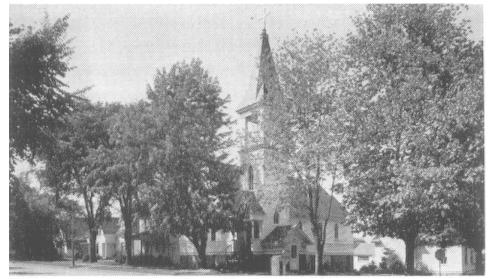 Pennsylvania.
They were active workers in the church and helped a great deal in getting
the organization started and later on in building the beautiful church
which still stands on the northwest corner of
Pennsylvania.
They were active workers in the church and helped a great deal in getting
the organization started and later on in building the beautiful church
which still stands on the northwest corner of
E. LaSalle Ave. and Eighth
St.
On April 7, 1892, St. Hilda's
Guild was organized. The meeting was opened with a prayer by Rector Rev.
E.F. Gee. These women became members: Mrs. Kinsley, Mrs. Ed. Coleman, Mrs.
Stone, Mrs. E.N. Stebbins, Mrs. Munroe, Mrs. McDonald, Mrs. Horsman, Mrs.
Whitmore, Mrs. Birdie Smith, Miss Boyer
and Alma Whitmore. On January
11, 1893, officers were elected and a set of by laws was adopted.
The congregation grew and a church was needed. Funds were raised and the corner stone of the church was laid on August 28, 1893. The church was built during the summer of 1896. There was no basement. The church was heated by stoves which burned 4 foot wood. (The Stebbins boys had the responsibility of keeping the fires going on Sundays.)
The first service in the
new church was held August 31, 1896. Rev. A.T. Young conducted the services.
The first funeral in the church was conducted for Frank Sprague Stebbins
in September, 1896. The first wedding was held in the church in 1897, when
Isabelle Stebbins and Rev. Young were married.
By 1901, the church was
free from all debt. In 1902, a suitable and comfortable rectory was built
at the rear of the church at a cost of $1400, and a furnace was installed
in the church. Carpet was laid, also.
Mr. E.W. Stebbins, Sr., died in 1903. He lived in Barron 12 years and served his church faithfully and was a man who was also interested in the welfare of this community. He served as mayor of this city for some time. Mrs. Stebbins died in 1909.
In 1925, the church building was raised to provide much needed place for social and recreational meetings. A guild room with a well equipped kitchen was installed in the basement. St. Hilda's Guild, whose faithful members have played a vital role in the history of this church, paid the cost of these improvements.
The clergymen who served
this church since it was organized follow:
Edgar F. Gee (1891-1893);
Francis Vey (1894-1895); A.T. Young (1896); F.S. De Mattos (1896-1897);
Fr. Cheney (1897); F.W. Wilson (1897-1898); R. Rowley (1898); Charles B.
Fosbroke (1899);
Henry Harris (April 1902);
Silas C. Walton (March 1905-1907); Henry E. Chase, assisted by
W.E. Vincent (1907- 1914);
Wm. F. Hood (1914-1917); Ralph E. Gentle (1917-1918); Milo B. Goodall
(1918-1929); Lester M.
Morse (1929-1936); Arthur R.P Heyes (1936-1945); Eugene Douglas (1945-1947);
Gerry Wall (1947-1949); Francis C. Reynolds (1949-1951); Putnam McKay (1951-1955);
Douglas G. McCreight (1955-1959); Thomas K. Sewall(1959- ).
Back to
top
The work of the Foursquare Gospel Church began the last week of June, 1930, when Miss Anna Kleist of Iowa came to Barron and started holding cottage prayer meetings as well as jail services, visiting the County Farm and the hospitals, and having children's church in the park.
For a period of time public services were held in the Lodge Hall on LaSalle Ave., above the feed store, (now the hardware across from Frazey's). Later services were held in the Anderson Hall, above Anderson's Hardware store, with Reverends Vern Cardiff and Finis Wahl holding special services.
This covered a period of time from 1930 to 1932.
In 1932, the first property was purchased, which is the location of the present church on the corner of Ninth Street and Division Ave.. Rev. and Mrs. Carl Dahlin purchased the lots from Charles Maxon in September of 1932, and erection of the Foursquare Tabernacle was started. Before completion of the tabernacle, Rev. Dahlin was transferred, and the building was completed by Rev. (Dad) Correll.
The first building, the Foursquare Tabernacle, was a frame building with sheet metal siding and roof, sawdust floors and wooden benches.
During the first four years, several ministers served as pastors of the Tabernacle; Rev. Wm. Stovall, Rev. Fred Jones, Rev. La Donna Dalrymple, and Rev. and Mrs. Herman Walters.
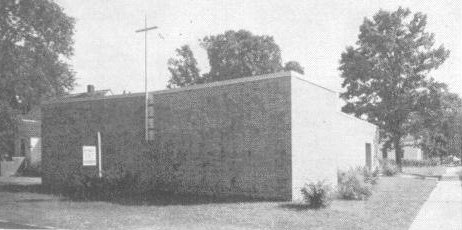 May
29, 1934, Rev. and Mrs. Fred E. Clements and their two daughters Annie
and Cora, assumed the pastorate of the Foursquare Church. This date marked
the beginning of seventeen years in the church, during which time a four
bedroom parsonage was built, besides many changes and improvements in the
May
29, 1934, Rev. and Mrs. Fred E. Clements and their two daughters Annie
and Cora, assumed the pastorate of the Foursquare Church. This date marked
the beginning of seventeen years in the church, during which time a four
bedroom parsonage was built, besides many changes and improvements in the
Tabernacle under the capable
leadership of Reverend Clements. The pastoral duties of Rev. and Mrs. Clements
terminated in the spring of 1951, due to the ill health of Rev. Clements.
Rev. and Mrs. Timmons and daughter, Bobbie, supplied as interim pastors between the resignation of Rev. Clements in the spring of 1951, and the arrival of Rev. and Mrs. Roland R. Johnston and daughters, Patricia and Joyce, in October of the same year, when they were appointed to the pastorate of the Barron Foursquare Church.
During the eight years of ministry of Rev. Johnston in the Barron Church, the old tabernacle was dismantled and the present brick and block church was erected on the same site, much of the building being done by the pastor and the men of the church who donated their time.
In the spring of 1959, Rev. and Mrs. Johnston resigned the pastorate and on June 17, the duties of the church were assumed by Rev. and Mrs. Delmer S. Walker, who, with their three daughters, Carol, Betty and Linda, and one son, Ralph, moved to Barron from near Chicago, Illinois.
The church at present has
a Sunday School enrollment of 163, with an average of between 110 and 120
in attendance.
Back to
top
Salem Evangelical Lutheran Church
This church was organized
January 15, 1893. On April 3, 1893, the members decided to build a church
28 feet by 40 feet. The church was built on the north east corner of the
6th Street and Division Ave. The total cost was $1,534.05. Rev. H.O. Rastin
of Shell Lake laid the corner stone. The congregation consisted of 15 families.
Rev. R.F. Nammacher was the first resident pastor. In 1895, a parsonage
was built and wooden sidewalks were installed on three sides of the church.
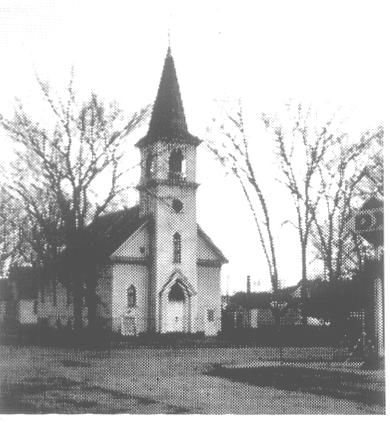
Shortly before 1900, the
two German Lutheran churches in Barron united. Before this union one had
been organized under the Wisconsin Synod and the other under the Missouri
Synod. In 1907, it was decided to hold one service in English per month
and in 1922, it was decided to hold English services
every other week. By 1922,
the congregation numbered thirty families, making a total membership of
200.
In 1924, the church was
raised and a full basement was installed. The total cost was $3,000.00.
By 1949, there were 80 families in the congregation. In this year
further improvements were made. More seating space, a chancel, a sacristy,
a council room and furnace room were added at a cost of $4,000.00.
Most of the work was donated
by members of the congregation. In 1952, a manual Wurlitzer organ was purchased.
There were four societies in the congregation; Ladies Aid, formed in 1907, the Sewing Circle, Luther League for young people, and the Men's Club.
On July 27, 1958, the church observed its 65th anniversary. Rev. Lloyd Lambert and Rev. Julius Wagner, former pastors, took part in the ceremonies.
Rev. Theodore Zaremba is pastor of this church at present. He came to Barron in 1955. The congregation has recently decided to build a new church on a five acre tract at the corner of E. Division Ave. and 14th Street. It will be a fine, modern structure. The main building will be 36 feet by 86 feet and will seat 310.
A large wing 44 by 80 feet will provide a large social hall, six class rooms, a kitchen, rest room facilities and the heating plant for the complete project. A third wing suitable for a parsonage may be built later on. On this site there will be ample parking facilities for all members of the congregation. One Ft. Atkinson contractor has estimated the cost at $100,000.00.
Mr. George Schmidt is president of the church council and has served faithfully on that council for the past 36 years. Other men who have rendered long and faithful services are: George Hamman, Will Krueger and Julius Zabel.
Pastors of this church during
the 67 years are as follows: H.O. Rastin (1893), Theo. Thormaehlen, J.
Frennd and Oswald Lungenhein, also in 1893; R.F. Namacher, (1893-1897),
George Kerchke, (1897-1898); H.J. Ableman, (1900-1903); Adolph Leaderer,
(1903-1908); Wm. Keturakat, (1909-1911);
Julius Wagner, (1911-1916);
Walter Motzkus, (1916-1927); Samuel Rathke, (1927-1947); Lloyd Lambert,
(1947-1955), and Theo Zaremba, (1955- ).
Back to
top
First Baptist Church of Barron
The first Baptist Church was organized on March 3, 1894, in Maple Grove. The meeting was held in the Johnson School House. Those who joined this church during the first few weeks of it's existence were: Mr. and Mrs. A.W. Arndt and their children, Michael and Minnie, Mrs. Philip Arnold and Edith Arnold, Mr. and Mrs. W.H. Ellis, Mrs. Harry Young, and Charley S. Sanderson.
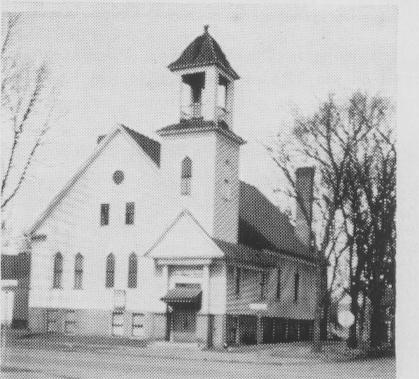 The
first name of this church was Immanuel Baptist Church. In April, 1895,
the name was changed to the First Baptist Church of Barron. For the next
two years the meetings were held in halls in Barron. In 1897, a church
was built. Church members gave generously of their time and labor and money
to make this project possible. Most of the lumber came from the trees cut
on the A.W. Arndt farm.
The
first name of this church was Immanuel Baptist Church. In April, 1895,
the name was changed to the First Baptist Church of Barron. For the next
two years the meetings were held in halls in Barron. In 1897, a church
was built. Church members gave generously of their time and labor and money
to make this project possible. Most of the lumber came from the trees cut
on the A.W. Arndt farm.
In 1913, the church was remodeled and enlarged to a seating capacity of 250. Other improvements, some of them in later years, included new oak floors, chimes and recording equipment, new lighting and a heating plant. In 1950, a fine, new parsonage was built just west of the church on Division Ave.
For some years this church has broadcast a church program over Rice Lake radio station, WJMC.
The present pastor, Rev. F.H. Stair, came to Barron in 1949. He is the twenty-third pastor of this church.
Records show that these
men served on the first board of trustees: S.R. Wiley, A.W. Arndt and W.H.
Ellis. The pastors who served this church from its beginning are as follows:
(most dates are not available), George B. Dissmore, S.S. Hageman, A.E.
Goff, G.S. Wain, H.E. Hoare, E.J. Parsons, G.W. Morton, H.A. Ericson, J.
McFarlane, J.W. Bell, J.C. Johnson, George Hamilton, H.H. Savage (left
in 1915), C.H. Dinsmore, (1917), David Alexander (1917-1921), S.M. Duyzers,
(1922), Lorraine M. Clark, (1924), H.E. Beldon, (1929), Ralph Spangler
(1930-1936), D.A. Clover, (1936), L. Solomon, (1939-
1949), F.H. Stair, (1949-
).
Back to
top
The First Lutheran Church of Barron
First Lutheran Church of Barron, Wisconsin, was organized on the 29th of March, 1884, with nine charter members. Prior to the organization, missionary work had begun in 1872 with services in homes and the Methodist Church in Barron. Pastors serving during this period were C.J. Helsem, H.Z. Hvid, N.I. Wikrie, and J. Waage. T.O. Juve served the church at the time of organization and until the year 1888. J.E. Nord served until 1890 and A.J. Orke until 1893.
In the year 1891, the congregation
built the first church with logs at a cost of $423.81. In 1893, Rev. J.
Urnes from Prairie Farm served the congregation and continued to do so
until 1900. In June 1899, the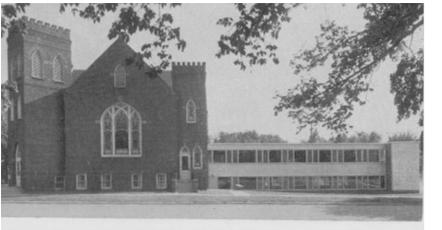 church was destroyed by a tornado. Immediately the congregation began to
build a second church which was completed in 1906 complete with belfry,
bell, altar, pulpit and other pieces. The cost was $2,253.10. The congregation
was served temporarily in 1901 and 1902 by H. Lund and J.B. Reynardson.
church was destroyed by a tornado. Immediately the congregation began to
build a second church which was completed in 1906 complete with belfry,
bell, altar, pulpit and other pieces. The cost was $2,253.10. The congregation
was served temporarily in 1901 and 1902 by H. Lund and J.B. Reynardson.
In the spring of 1903 the
congregation was served with the Dallas and New Scandinavia churches and
Rev. Lund was pastor. In 1912, the congregation withdrew from the Dallas
parish and formed a parish with Poskin. In 1915, Faith Lutheran at Cameron
was added to the parish. Rev. N.B. Ursin was called as pastor in 1912 and
served until the spring of 1919. In 1914, First Lutheran celebrated
the thirtieth anniversary, and for this occasion, Rev. Ursin worked out
a brief history wherein partly he says: "In these thirty years 353 have
been baptized, and 217 confirmed. From the small beginning of nine families
as charter members, the congregation has grown to seventy two families
with four hundred souls."
In 1920, Rev. E.B. Swenson,
a graduate from Luther Theological Seminary in St. Paul, Minnesota, was
called and installed in June of the same year. Rev. Swenson served the
congregation for six years. On January 26, 1922, the second church was
completely destroyed by fire. The congregation began
immediately to construct
the third church building. The corner stone was laid June 22, 1922, and
the church completed the same year. During the construction of the church,
services were conducted in the Salem Lutheran Church. The new brick church
was built at a cost of $30,000.00. A history of the church by Rev. E.B.
Swenson states, "The congregation consists at present of 98 families, 309
confirmed members, 123 voting members and 475 souls." In 1926, Rev. B.B.
Ostrem was called as pastor. He was installed on New Year's Day, 1927.
Rev. Ostrem served the congregation for 19 years. On June 18, 1944, the
69th anniversary of the congregation was celebrated. From Rev. Ostrem's
historical sketch we quote: "Through these sixty years the means of grace
have been faithfully administered and used. Eternity alone can reveal the
blessed fruits of this activity."
In 1945, a call was extended
to Rev. P.E. Van Tassel who was installed on March 31, 1946, by Dr. T.F.
Gullixson of Luther Theological Seminary of St. Paul, Minnesota. He served
the congregation for 10 years. In the fall of 1947 work was begun on a
new parsonage and dedicated on Palm Sunday, March
21, 1948 by Dr. Martin
Anderson, President of the Eastern District, Evangelical Lutheran Church.
On Sunday, October 23, 1949, the congregation observed its 65th anniversary.
On that day the congregation had 230 families, 560 confirmed members, and
780 souls in the congregation. The enrollment in the Sunday School was
205 children.
On July 3, 1955, ground
breaking ceremonies were held for the new education building. The corner
stone was laid on November 27, 1955, and dedicated on Sunday, September
23, 1956. Rev. P.E. Van Tassel returned for the dedication and delivered
the sermon at the morning worship services. The Rev. H.A.
Hanson, assistant to District
President, Dr. Myron Austinson, dedicated the building. The building, complete
with furnishings, was built at a cost of $102,000.00. Mr. Harold Clausen,
Mr. Sigfrid Nelson and Mr. Arnold Ellison served on the building committee.
Officers serving during the construction were Herman Severson, Pres., Thorsten
Moberg, Sec., and Thoreld Moberg, Treas.; Trustees were Martin Anderson,
Erling Christianson, Otis Berger, Harry Johnson, and Woodrow Haugen. Deacons
were Arthur Kirkeby, Milton Jacobson, Ellis Amdall, Arnold Ellison, and
Irvin Jasperson.
In the year 1956, Rev. E.J. Nesset was called and was installed in the parish in May of the same year. In 1957, Rev. Carmen P. Thronson was called and installed on August 11th by Dr. Myron C. Austinson, President of the Eastern District. At present, the congregation numbers over 1200 baptized members. There were 350 enrolled in the Sunday School.
The congregation has given
to the ministry, one son, Rev. E.C. Nordby, and one daughter, Lorraine
Haugen, to the Sudan Mission in Africa.
Back to
top
It was in 1903 that the
Peniel Church of Maple Grove was organized into the Free Methodist Church.
After the intervening years of worshiping there, in September, 1956, the
members of the Free Methodist Church in Maple Grove purchased the pink
stone church beside the river on Highway 8 in Barron from Ed. Sprague of
Rice Lake. The church, parsonage, garage and acre of ground were purchased
for $10,000 through the generous consideration of Mr. Sprague. It
included pews, pulpit, piano and automatic oil furnace. To the band of
believers in Maple Grove, it was nothing else than a miraculous answer
to prayer. Scarcely a month previous to this time, an offer for twice this
amount had been rejected (which was also far below the actual evaluation
of the property). Since moving into town, their membership has nearly doubled
and church attendance tripled.
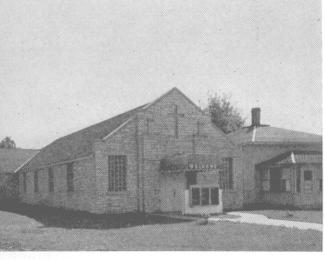
The Barron Free Methodist
Church is privileged to observe a "double centennial". They join others
in the Barron centennial as well as observing their own denominational
centennial. It was in 1860 at Pekin, New York, that the denominational
Free Methodist Church was organized after leading preachers and laymen
had been expelled from the Genessee Conference of the Methodist Episcopal
Church in New York for being too spiritual. The name "Free Methodists",
was adopted to stress the fact that they were very
decidedly of the Methodist
tradition, being "Methodists at heart", and "free" because they were opposed
to the slavery system (then a vital issue) and there were to be free seats
throughout the church (a custom prevailed then of paid pews in certain
sections). At the centennial celebration of the Genesee Conference of the
Methodist Church held in Rochester, New York, in 1910, that body publicly
apologized; restored the parchments to the families of the then deceased
ministers; and invited the Free Methodists back into the parent body. A
spokesman of that conference, Ray Allen, said at this occasion, "Those
expelled brethren were among the best men the conference contained and
scarce any one thought otherwise even then........" The reunion of the
two churches was never consummated. This year a General
Conference of the Free
Methodist Church is to be held at the denominational headquarters at Winona
Lake, Indiana with emphasis being made on its centennial observance.
Incidentally, one of the four presiding bishops was born in the Free Methodist parsonage in the town of Maple Grove, Barron County. He is Bishop Walter S. Kendall. He preached his first sermons there in Maple Grove and has held revival meetings there in previous years.
The Free Methodist Church
is glad to share in the observance of the Barron Centennial.
Back to
top
Saint Joseph's Catholic Church
At the beginning of the century, a few Catholic families lived in Barron. Father Francis Bourg, the Pastor of Almena, made trips to Barron to minister to their spiritual needs.
In 1909 the small congregation bought three lots on E. LaSalle Ave., which was densely wooded then. The old Ward school building, which was built in 1881, was purchased by the congregation and moved to E. LaSalle where it was remodeled for a church.
The Barron church was attached to the Chetek Parish as a Mission. The priests from Chetek took care of the Barron congregation until 1941, when Barron became a parish.
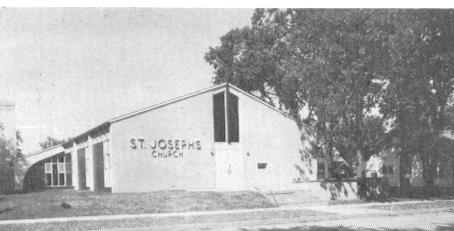 Father
Roman Fassbender was the first resident pastor. He came to the parish in
November, 1941. A house beside the church was purchased for a rectory,
which is the present one. With the coming of Father Fassbender, more families
moved into the parish. On December 1, 1943, Father Fassbender died.
Father
Roman Fassbender was the first resident pastor. He came to the parish in
November, 1941. A house beside the church was purchased for a rectory,
which is the present one. With the coming of Father Fassbender, more families
moved into the parish. On December 1, 1943, Father Fassbender died.
In October, 1944, Father Ignatius Kinney was appointed pastor. The little parish continued to grow so that in 1950 the congregation numbered over fifty families.
Father James Harte was appointed
pastor on February 16, 1950, to succeed Father Kinney. With the continued
increase in the number of families, it was soon realized that the old church
was too small. Father Harte went to see Cardinal Meyer, who was then Bishop
of Superior, concerning the need of
accommodation for the growing
parish. Cardinal Meyer decided that a new church should be built.
In September, 1957, the
old church was razed and the construction of a new church began. The new
church was completed in late 1958. The congregation is very proud of its
modern cruciform church, which has a seating accommodation for 350. The
parish now numbers ninety four families.
Back to
top
First Methodist Church of Barron
This church began on December
3, 1876, when a few Barron residents met at the courthouse and heard a
sermon preached by Rev. K.A. Fulmer of Prairie Farm. He had charge of the
Sumner Circuit. He planned to preach here every other Sunday, but bad roads
sometimes prevented him from coming. On May 20,
1877, a Sunday School was
organized. Ten children were present.
Rev. William Haw held quarterly conference here in August, 1977. The Mite Society was organized about 1880. At first it was composed of women of several faiths. By 1896, it became strictly Methodist. By that time other churches had organized and set up their own working societies in each church.
Church was being held in the frame school house which was located north of Division Ave., where the Ward School now stands, by the year 1882. In 1883, when Rev. James Conner was pastor, funds for building a church were solicited. The church was built in 1885 and was dedicated August 28, 1886.
Rev. G.W. Pepper was the first resident pastor. He came here in the fall of 1887. In 1894, a parsonage was completed. The Woman's Home Missionary Society was organized July 10, 1894. Mrs. Sarah Parr was the first president.
In 1897, the church was enlarged; a basement, a tower and a heating plant were added to the old church. In 1908, the church was remodeled and a pipe organ was installed. In June, 1909, the church was rededicated. Mrs. C.S. Taylor, who was a member of the choir, declares that four male members sang in the choir with her for forty years and more. They were: J.F. Coe, L.S. Cheney, W.B. Crawford and A. Crawford.
In 1947, a building fund
for a new church was authorized. By the end of 1948, the fund had grown
to 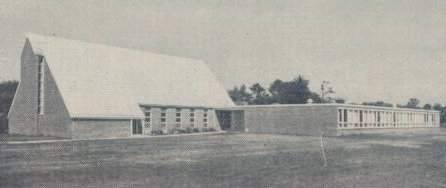 $7,450.00.
From 1948-1955, three fund raising campaigns brought in pledges of $25,971.00.
In November, 1955, a fund raising crusade conducted by Rev. C.M. Fritz
was started. A goal of
$7,450.00.
From 1948-1955, three fund raising campaigns brought in pledges of $25,971.00.
In November, 1955, a fund raising crusade conducted by Rev. C.M. Fritz
was started. A goal of
$45,000.00 was set. Pledges
totaled $54,000.00. Mr. and Mrs. Herman Williams gave one and one-half
acres of land for a building site and the church purchased an additional
one and one half acres.
On May 6, 1956, the work on the new church began and on September 30, 1956, the corner stone was laid. On March 17, 1957, the fine, new church was consecrated. During 1958-1959 a new parsonage, east of the church, was built. It was dedicated January 3, 1960.
The new church is located south of Quaderer Creek and east of Memorial Drive. It is a splendid brick structure of contemporary design and 300 can be seated in its pews. For larger gatherings, chairs can be placed back of the pews. The spacious basement has a modern fully equipped kitchen and ample space for tables and chairs for social gatherings. Over the kitchen are two Sunday School rooms. In the Sunday School building are two large class rooms and five smaller class rooms.
The membership of the church has grown steadily over the years and now numbers 518. The new church was erected at a cost of $215,000.00, and the parsonage at a cost of $21,000.00. The members of this church may well be proud of their splendid, new church and parsonage.
Pastors for the past seventy
years are: G.W. Pepper, 1891-1892; S.M. Griffin and Elmer Sidel, 1892-1895;
H.P. Blake, 1895 to 1896; E.C. Dixon, 1896 to 1901; M. Benson, 1901 to
1907; George Kershaw, 1907 to 1912; Emmanual Harris, 1912 to 1918; R. Harold
Gee, 1918 to 1920; William H. Penn, 1920 to 1923; Andrew M. Harkness, 1923
to 1927; Daniel H. Fleet, 1927 to 1936; Clarence E. Weed, 1936 to 1939;
George Bell, 1939 to 1943; Archie R. Henry, 1943 to 1949, Rev. Harold A.
Allison has served as pastor since 1949.
Back to top
Last Update